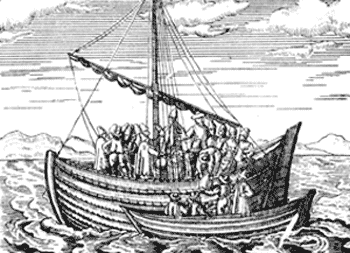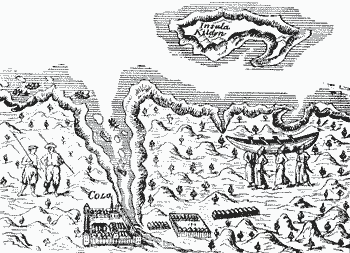 |
 |
| |
Engraving of ancient
Pomor's boat (ladia) from old books. Image courtesy
Ecoshelf. |
 |
|
 |
 |
 |
Ancient map of Kola Bay and Kildin
Island. The Barents Sea coast. Image courtesy Ecoshelf. |
History
Ancient Times (up to 15th century)
A foremost Arctic explorer in his own
right, Fridtjof Nansen wrote on the exploration of the North
Atlantic by western civilizations in ancient times. Nansen's
account begins in antiquity with the discovery of Thule (which
Nansen suspected was Norway, but now is believed to be Iceland)
by Pytheas of Massalia (now Marseilles) around 330 BC. Nansen
continues with subsequent voyages in Roman and Medieval times,
the settlement of Scandinavia, and discovery and settlement
of Iceland, Greenland, and Wineland (North America) by the Vikings.
Also described are Norwegian expeditions to the White Sea and
the Polar Sea, whaling and sealing, John Cabot's discovery of
North America at the end of the 15th century, and Portuguese
encounters with Greenland at about the same time.
Farther to the east, many historians believe that Pomors (Russians
from the town of Novgorod) first began to appear in the far
north along the coast of the White Sea at the beginning of the
12th century, and along the Murmansk coast in the middle of
the 13th century. Every year, the Pomors sailed along the northern
coast in boats that were constructed using axes. Sometimes storms
forced the boats from their usual shipping lanes, leading to
observation of the islands of Novaya Zemlya, Spitsbergen, and
Bear Island. In fact, Spitsbergen was visited by the Pomors
150 years prior to being discovered by the Dutch in 1596. About
the same time, other Russian adventurers crossed the Ural Mountains,
entered North Siberia and reached the Lower Ob River.
Reference:
Nansen, F., In Northern Mists, Vols I & II, AMS Press,
New York, 1969.
 Previous Chapter
Next Chapter Previous Chapter
Next Chapter

|



